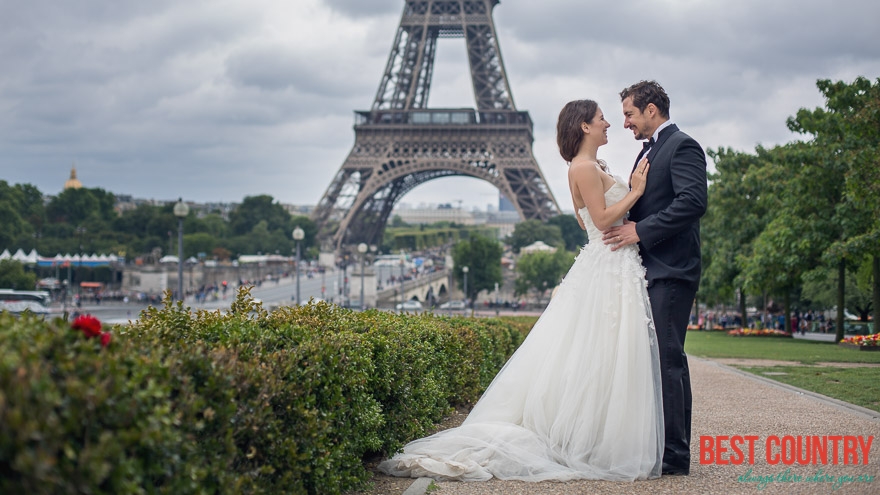France has always been a crossroads of Europe, so it should be no surprise that French wedding customs are a rich mix of customs from other cultures together with those nurtured in the most romantic country in the world.
Wedding Customs in France
During the Middle Ages, the prospective Breton groom left a hawthorn branch for his sweetheart as a signal she was his chosen bride. Hawthorn has been used as a herbal remedy for heart problems for centuries. Other grooms used the village tailor as a go between who arranged things with the girl and her parents.
 Confirming an engagement with a gift of jewelry is an ancient custom, but diamond jewelry first caught the attention of fashionistas at the court of King Charles VII when he gave diamonds to the notorious Agnès Sorel rather than to his wife, thereby proving himself the true son of his father, Charles the Mad.
Confirming an engagement with a gift of jewelry is an ancient custom, but diamond jewelry first caught the attention of fashionistas at the court of King Charles VII when he gave diamonds to the notorious Agnès Sorel rather than to his wife, thereby proving himself the true son of his father, Charles the Mad.
French brides to be receive the credit for the idea of the trousseau, originally a collection of clothing and household linens stored in a hope chest or elaborately carved armoire.
This armoire was destined to become a central piece of furniture in the household of the newlyweds. Some sources go further and suggest the concept of the trousseau contributed to the development of the bridal showers we hold today.
Since regular bathing was not possible without elaborate plumbing, a pre-wedding bath became a necessary custom for French brides Рand hopefully their fianc̩s Рthough whether bathing grew from a desire for cleanliness or ritual purification is unclear.
Certainly, richly scented flowers have always played an important part in French weddings. Their aroma contributes to the overall beauty of the service, and the traditional romantic language of flowers adds to the message of love and joy.
However, there was a time when the fashion for orange blossoms outstripped the seasonal supply, and some brides resorted to orange blossoms made of wax.
While Anne of Brittany is widely credited with wearing the first white wedding dress, it was Queen Victoria's friend and contemporary, the Empress Eugénie, who made white the color of choice in France.
Today's French bride wears a chic, flattering wedding gown, but regional costumes were once popular. In Brittany for example, brides yearned for elaborately skirted dresses of white and purple velvet and gold cloth.
The charming village custom of the groom to be escorting his fiancée and the wedding party to the church for the ceremony has survived.
In Brittany, children block the road with ribbons that must be cut by the bride. The groom has to remove briars that have been placed across the road by those who demand and receive payment for these obstacles.
Once the guests have gathered at the church, the groom and his mother precede the rest of the wedding party down the aisle.
Near the end of the ceremony, a protective square of silk, called a "carré," is held over the heads of the bride and groom as they are blessed by the priest. This same silk will wrap their children when they are baptized.
Like couples almost everywhere, French newlyweds can expect their guests to fling something at them as they leave the church.
Depending on local custom, guests might throw grains such as wheat or rice for fertility or even gift the bride with loaves of bread. Elsewhere, guests toss almond dragées or coins at the couple who walk over aromatic laurel leaves strewn outside the door of the church.
Toasts of "health" or "santé" to the bride and groom hark back to actual toast. Even today, a piece of bread may be placed in a traditional two-handled cup along with wines from two different vineyards. This represents the couple's union, and after they drink the wine, they eat the bread, a symbol of life.
The French often hire a professional champagne opener for weddings. This expert uses a saber, a Napoleonic cavalry-style sword, to whack open bottles of celebratory champagne.
The croquembouche has been the traditional French wedding cake since the 1600s. This "mouth cruncher" is a golden dream consisting of a pyramid of creampuffs covered with hard-crack sugar and then spun, lightly caramelized sugar.
The concept originated from an earlier time when guests would stack little cakes and call for the newlyweds to kiss over the stack without disturbing it.
Dancing is a popular pastime at French weddings. In Brittany, the traditional dance is the "rond" in which people join hands and dance in a circle.
Bridal garters and bouquets have been tossed at French weddings for hundreds of years.
Originally, it is suspected the garter was hurled in the faces of drunken guests, but flowers have always been thrown to whomever will be next to marry.
French wedding guests have long believed in extending their participation in the festivities to the wedding night.
They purposefully disturb the new couple with loud noises and drunken songs in return for another drink or two with the bride and groom. This practice is called variously "chiverie" or "charivari."
French settlers brought the chiverie to North America where it became known as a "shivaree."
When the celebrations wind down, someone may head to the kitchen to prepare a strengthening onion soup as a morning after pick-me-up.
Your own wedding will be richer if you choose to enhance it with a judiciously chosen wedding custom from France.